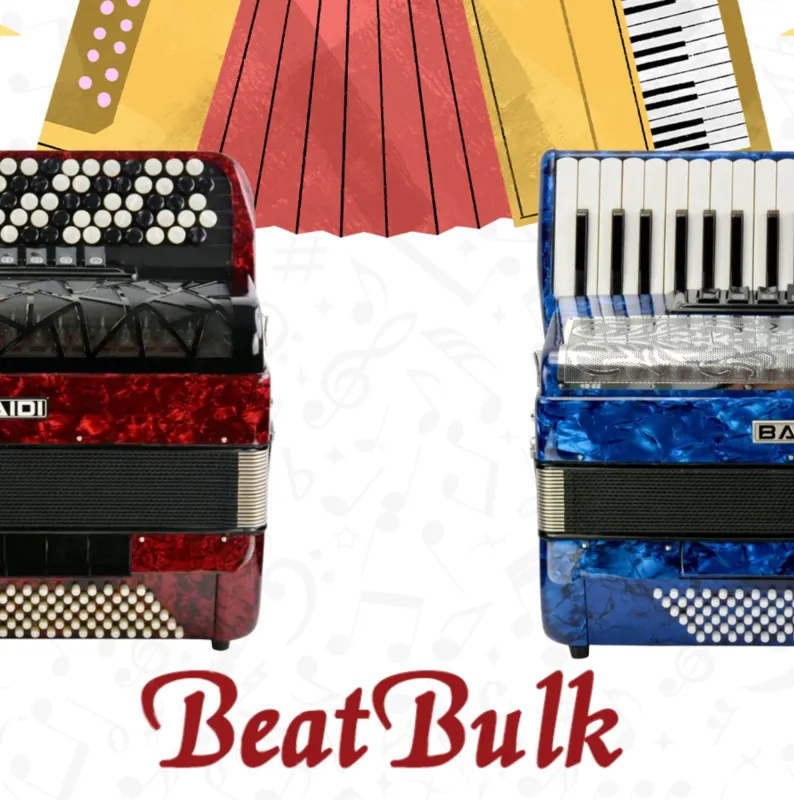Resumen
The diatonic button accordion is one of the most expressive and traditional instruments in folk and regional music worldwide. Unlike piano accordions, it uses buttons for both melody and bass, offering a unique sound and playing technique. This article provides a complete guide for beginners and music educators who want to learn how to play, understand its layout, and develop practical skills step by step. Whether you’re a music school, band member, or instrument distributor, this guide will help you understand the diatonic button accordion’s structure, playing techniques, and maintenance essentials.
Principales conclusiones
- A diatonic button accordion uses buttons instead of piano keys and produces different notes when the bellows are pushed or pulled.
- It’s ideal for folk, traditional, and dance music due to its rhythmic and melodic versatility.
- Understanding its layout and fingering system is essential before practicing tunes.
- Beginners should start with a beginner accordion model with fewer buttons.
- Consistent practice and proper posture are key to mastering this instrument.
Índice
- Introduction: What is a Diatonic Button Accordion?
- Diatonic vs. Piano Accordion: Key Differences
- Understanding the Layout
- How Sound Is Produced
- Choosing Your First Diatonic Button Accordion
- Basic Playing Techniques
- Common Diatonic Scales and Tunes
- Practice Exercises for Beginners
- Maintenance and Care Tips
- Common Mistakes to Avoid
- PREGUNTAS FRECUENTES
- Conclusión
- Ready to begin your accordion journey or expand your store’s selection?
- Referencias
Introduction: What Is a Diatonic Button Accordion?
A diatonic button accordion is a type of acordeón designed with buttons rather than piano-style keys. It is called “diatonic” because each button produces two different notes—one when the bellows are pushed and another when pulled.
This push-pull mechanism gives the instrument its lively, rhythmic sound, often heard in traditional genres like Irish, Cajun, Tex-Mex, and folk music across Europe and Latin America.
The diatonic button accordion is lighter and more compact than chromatic or piano accordions, making it easier for beginners and traveling musicians.
Diatonic vs. Piano Accordion: Key Differences
| Característica | Acordeón diatónico de botones | Piano Acordeón |
|---|---|---|
| Keyboard type | Buttons | Piano keys |
| Note pattern | Changes with bellows direction | Same in both directions |
| Scales available | Limited to certain keys | Fully chromatic |
| Size and weight | Compact and light | Larger and heavier |
| Music style | Folk, traditional, ethnic | Classical, pop, jazz |
| Difficulty for beginners | Easier to start but harder to master scales | Easier to visualize notes |
Understanding these differences helps you choose the right instrument depending on your musical goals.
For instance, if your focus is on folk or dance music, the diatonic button accordion offers a more authentic sound and phrasing. Learn more here: Acordeón de botones frente a acordeón de piano: ¿cuál es la diferencia clave?

Understanding the Layout
A diatonic button accordion typically has:
- Treble (right-hand) side: Rows of melody buttons (each row tuned to a specific key).
- Bass (left-hand) side: Buttons for bass notes and chords.
- Bellows: The expandable part that pushes air through reeds to create sound.
Each row of melody buttons corresponds to a diatonic scale. A common model may have two or three rows, tuned to keys like G/C or D/G.
When you push o pull the bellows, air flows differently, causing each button to produce two notes (one on push, one on pull).
This “bisonoric” characteristic is what makes the diatonic button accordion unique.
How Sound Is Produced
Sound on a diatonic accordion is created when air passes through metal reeds. Each button controls a valve that opens the path for air to reach the reed.
By pushing or pulling the bellows, you direct airflow in opposite directions, producing alternating notes.
Key components involved:
- Reeds: Vibrating metal tongues producing specific pitches.
- Válvulas: Control air access to reeds.
- Bellows: Provide the air pressure needed for vibration.
- Buttons: Activate the valves for melody and bass.
This simple yet clever design is what gives the diatonic accordion its distinct, bright tone.
Choosing Your First Diatonic Button Accordion
When selecting your first instrument, focus on comfort, key layout, and build quality.
For students and beginners, a Acordeón para principiantes with two rows (e.g., G/C) is a practical choice.
Consider the following:
- Number of Rows: Start with two.
- Button Size: Larger buttons are easier for learners.
- Weight: Choose a light model for better control.
- Afinación: Popular tunings are G/C, D/G, and C/F.
- Straps: Adjustable shoulder straps enhance comfort during long practice sessions.
If you are a music school o instrument distributor, stocking multiple key tunings allows students to match local music traditions.
Basic Playing Techniques
1. Posture and Hand Position
Sit or stand comfortably with both straps secured.
Your right hand operates the melody buttons, while your left hand handles the bass and chords.
Keep your elbows relaxed and wrists slightly bent. Avoid excessive tension—it affects rhythm and bellows control.
2. Bellows Control
The bellows act as the lungs of the accordion. Mastering them is essential for dynamics and phrasing.
Tips for better bellows control:
- Maintain steady pressure—avoid jerky movements.
- Coordinate breathing with music phrases.
- Practice slow push-pull transitions to produce a smooth tone.
- Keep the following direction in mind—each direction produces different notes.
3. Right-Hand Melody
Each row of buttons follows a diatonic scale. For example, in a G/C accordion:
- One row plays in G major
- The other plays in C major
Practice simple scales up and down each row to understand push/pull note patterns.
Start with short folk tunes like “Oh! Susanna” or “La Raspa” to develop coordination.
4. Left-Hand Bass
The left side produces rhythm and harmony. Each button generally offers:
- Bass note (root of the chord)
- Chord button (major or minor triad)
For example, pressing the “C” bass button might sound a C note when pushed and a G note when pulled.
Beginners should start by alternating bass and chord buttons in a steady rhythm—this builds the foundation for dance accompaniments.
Common Diatonic Scales and Tunes
Below is a simple reference chart of push and pull notes for a common two-row G/C accordion:
| Button No. | Push Note (G Row) | Pull Note (G Row) | Push Note (C Row) | Pull Note (C Row) |
|---|---|---|---|---|
| 1 | G | A | C | D |
| 2 | B | C | E | F |
| 3 | D | E | G | A |
| 4 | F# | G | B | C |
| 5 | A | B | D | E |
By practicing these note transitions, players gradually build familiarity with both rows and can smoothly combine melody and bass.
Popular beginner tunes include:
- “The Irish Washerwoman”
- “Polka Italiana”
- “Cajun Two-Step”
Practice Exercises for Beginners
1. Scales and Arpeggios
Practice major scales on both rows daily.
Try:
- G major (push-pull pattern)
- C major (push-pull pattern)
Then practice arpeggios—play the root, third, and fifth notes of each chord.
2. Push-Pull Coordination
Play two-note combinations slowly while alternating bellows direction. This builds muscle memory and below awareness.
3. Bass-Chord Alternation
Use the left hand to alternate between a bass note and a chord.
Count aloud “one-two, one-two” while keeping the rhythm steady.
4. Simple Folk Melodies
Once comfortable with scales, start learning short folk melodies. Break each phrase into sections, practice slowly, then increase speed.
5. Daily Routine Example
| Time | Practice Focus | Goal |
|---|---|---|
| 10 min | Bellows control | Smooth direction change |
| 15 min | Scales & arpeggios | Even tone and rhythm |
| 20 min | Left-hand rhythm | Consistent beat |
| 15 min | Tune practice | Accuracy and phrasing |
Regular short sessions are better than one long session. Consistency leads to progress.
Maintenance and Care Tips
Proper maintenance ensures your accordion lasts for years.
Basic care tips:
- Store it in a dry place; avoid humidity.
- Use a soft cloth to clean the buttons and exterior.
- Do not force the bellows when closed.
- Periodically check straps and bellows for wear.
- Have the reeds tuned by a professional if they sound uneven.
For music schools or retailers, demonstrate maintenance during lessons or product demos—it builds user confidence and trust.
Common Mistakes to Avoid
- Ignoring Bellows Direction – Beginners often forget that push and pull create different notes.
- Using Excessive Force – Pressing buttons too hard can wear reeds prematurely.
- Neglecting Left-Hand Practice – Balanced coordination is key to rhythm.
- Skipping Warmups – Simple scales improve accuracy and prevent stiffness.
- Poor Instrument Setup – Wrong strap adjustment can cause shoulder fatigue.
By recognizing these issues early, learners develop better control and musicality.
PREGUNTAS FRECUENTES
Q1: What is the main difference between a diatonic and a chromatic accordion?
A diatonic accordion plays in specific keys and changes notes when pushing or pulling, while a chromatic accordion can play in any key with the same note layout in both directions.
Q2: Can beginners start directly with a diatonic button accordion?
Yes. Many players find the diatonic system intuitive once they understand its push-pull logic. Starting with a Acordeón para principiantes model makes the process easier.
Q3: How long does it take to learn basic tunes?
With daily 30-minute practice, most learners can play simple tunes within 1–2 months.
Q4: Is tuning different across countries?
Yes. Common tunings include G/C (Europe), D/G (UK), and C/F (Germany). Choose based on your regional repertoire.
Q5: Can I repair my accordion myself?
Minor cleaning is fine, but tuning or reed replacement should be handled by a professional technician.
Conclusión
Learning the diatonic button accordion is a rewarding musical journey. It combines melody, rhythm, and harmony in one compact instrument.
By understanding its layout, mastering bellows control, and practicing regularly, you can quickly progress from basic scales to complete folk tunes.
For music schools, this instrument is an excellent teaching tool for developing ear training and rhythm skills.
For distributors, offering quality models in various tunings supports a wide range of cultural music styles.
The key to success is patience, consistency, and the right instrument.
Ready to begin your accordion journey or expand your store’s selection?
Explore our collection of premium accordion models and find the perfect Acordeón para principiantes to get started.
👉 Visit BeatBulk.com today to discover quality instruments trusted by schools, musicians, and distributors worldwide.
Referencias
- “The Art of the Diatonic Accordion,” by John Kirkpatrick, Folk Press, 2018.
- “Accordion Maintenance and Care,” International Accordion Society, 2022.
- “Traditional Music Styles and the Diatonic Accordion,” Folkways Journal, 2021.
- BeatBulk Musical Instruments – Accordion Collection. Retrieved from https://www.beatbulk.com/category/accordion/







